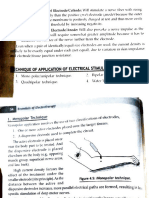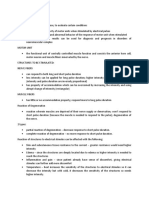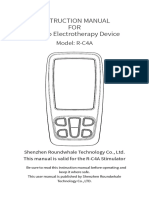Use of Peripheral Nerve Stimulator To Monitor
Use of Peripheral Nerve Stimulator To Monitor
Uploaded by
Turlough LynchCopyright:
Available Formats
Use of Peripheral Nerve Stimulator To Monitor
Use of Peripheral Nerve Stimulator To Monitor
Uploaded by
Turlough LynchOriginal Description:
Original Title
Copyright
Available Formats
Share this document
Did you find this document useful?
Is this content inappropriate?
Copyright:
Available Formats
Use of Peripheral Nerve Stimulator To Monitor
Use of Peripheral Nerve Stimulator To Monitor
Uploaded by
Turlough LynchCopyright:
Available Formats
Nursing Service Guidelines
General
Title: USE OF PERIPHERAL NERVE STIMULATOR TO MONITOR NEUROMUSCULAR
BLOCKADE (NMBA).
Responsibility: RN's caring for patients receiving neuromuscular blocking agents
Equipment: 1. Peripheral Nerve Stimulator
2. Two gelled electrode pads (such as those used for external cardiac monitoring)
Standard of Use of peripheral nerve stimulator (PNS) by train-of-four (TOF) method to determine depth
Care: of paralysis of patients receiving non-depolarizing neuromuscular blocking agents.
Procedure Point of Emphasis
1. Setting up the Peripheral Nerve Stimulator: The optimal placement of the electrodes is the ulnar
Apply the two electrodes either at the ulnar nerve nerve. However, the conduction of the impulses is
area, the facial nerve area or the posterior tibial affected by wounds, edema and invasive lines, and
nerve area. (Please see pictures below to verify hair, therefore, if any of these are present the facial
proper placement.) nerve or the posterior tibial nerve should be used
instead.
Ulnar nerve area placement of electrodes:
Place the distal electrode on the skin at the flexor
crease on the ulnar surface of the wrist. Place
the second electrode approximately 1-2 cm. proximal
to the first, parallel to the flexor carpi ulnaris tendon.
Facial nerve area placement of electrodes:
Place one electrode on the face at the outer canthus
of the eye and the second electrode approximately 2
cm below, parallel with the tragus of the ear.
Posterior tibial nerve placement of electrodes:
Place one electrode approximately 2 cm from the
posterior to the medial malleolus in the foot. Place
the second electrode approximately 2 cm above the
first electrode.
NOTE: It is important to carefully place the
electrodes, to avoid direct stimulation of the
muscle rather than the nerve. If the electrodes
are placed on the muscle, it is impossible to
accurately assess the effect of the NMBA.
Initiation and Termination of Dialysis Procedure K13
Using Double Lumen Dialysis Access Catheters
Page 2
Practice Guidelines Points of Emphasis
Plug in the lead wires to the nerve stimulator, Ulnar Nerve Placement: Connect the negative
attaching the negative (black) and positive (red) (black) lead to the distal electrode over the crease of
leads to the black and red connection sites. the palmer aspect of the wrist and the positive (red)
lead to the proximal electrode.
Facial Nerve Placement: Connect the negative
(black) lead to the distal electrode at the tragus of the
ear and the positive (red) lead to the proximal
electrode at the outer canthus of the eye.
Posterior Tibial Nerve Placement: Connect the
negative (black) lead to the distal electrode 2 cm
posterior to the medial malleolus in the foot.
Connect the positive (red) lead to the proximal
electrode 2 cm above the medial malleolus.
Turn on the PNS and select a low mA (10 to 20 Excessive amount of mA can lead to over stimulation
mA is typical). and repetitive nerve firing.
b. Depress the TOF button and observe and count Finger movements are a result of muscle stimulation,
the number of twitches of the thumb (do not not nerve stimulation. In a person not receiving
count finger movements, only the thumb), the NMBA therapy, a TOF stimulus, produces four serial
number of twitches of the muscle above the thumb adductions. In a person receiving NMBA
eyebrow or the number of twitches of the great therapy, the twitches gradually fade. For example,
toe. may see only 2 twitches in a person receiving
NMBA therapy.
Four electrical stimuli are given at 0.5 second
intervals.
The set of four stimuli should not be repeated more
frequently than every 20 seconds, otherwise over
stimulation can occur.
2. Determining the Supramaximal Stimulation If there is no increase in intensity of the muscle
(SMS). twitch when the mA is increased, the SMS is the
a. Increase the mA in increments of 10, until level at which four vigorous twitches was observed.
four twitches are observed. For example, if a strong response was observed at
b. Note the mA that corresponds to four vigorous 20mA, raise the current to 30 mA. If there is no
twitches. Administer one to two more TOFs. increase in intensity of the twitch, the SMS is 20mA.
If there is an additional increase in twitch intensity,
raise it to 40. If the intensity shows no further
increase, the SMS is 30 mA.
Initiation and Termination of Dialysis Procedure K13
Using Double Lumen Dialysis Access Catheters
Page 3
Practice Guidelines Points of Emphasis
3. Determining the TOF response during NMBA
infusion.
a. Assess electrode condition and placement for
quality.
b. Retest the TOF 10 to 15 minutes after a bolus Evaluates the level of blockade provided.
dose and/or continuous infusion of NMBA is
given/initiated/changed.
c. If more than one or two twitches occur and Signifies that less than 85% to 90% of receptors are
neuromuscular blockade is unsatisfactory for blocked.
clinical goals, increase the infusion rate as
prescribed or according to hospital protocol
and retest in 10 to 15 minutes.
d. Retest every 4 to 8 hours after clinically stable Evaluates the level of blockade and avoids under-
and a satisfactory level of blockade is and overestimation of blockade.
achieved.
4. Troubleshooting when there is zero twitches.
a. Change electrodes. Dry electrode gel or poor contact effects conduction
b. Check lead connections and PNS for
mechanical failure (i.e. change the battery)
c. Increase the stimulating current.
d. Retest another nerve (the other ulnar nerve or
facial or posterior tibial nerves).
e. If there are no other explanations for a zero Excessive neuromuscular blockade produces absence
response, check the NMBA rate infusion dose of twitch response. The desired goal is 1-2 brisk
and concentration. Reduce the infusion rate twitches, as this represents 85-90% receptor
as needed. blockade. Adjust infusion rate of NMBA based upon
clinical indicators and TOF testing in order to obtain
the 1-2 twitches. Maintaining a receptor block of
greater than 90% has been linked to long-term
complications such as muscle weakness, prolonged
paralysis and difficulty weaning from the ventilator.
In addition, longer hospital stays result.
Initiation and Termination of Dialysis Procedure K13
Using Double Lumen Dialysis Access Catheters
Page 4
Practice Guidelines Points of Emphasis
5. Patient monitoring and care issues
a. Cleanse and dry the skin before applying the Improves contact and adhesion of electrode.
electrodes.
b. Change the electrodes whenever they are loose
or when gel becomes dry.
c. Select the most accessible site with the smallest
degree of edema, with no wounds, catheters, or
dressings that impede accurate electrode
placement over the selected nerve.
d. Never use the “Single Twitch”, “Tetany” or These are less accurate and can cause severe
“Double Burst” settings if available on the discomfort for the patient.
PNS.
e. The patient may demonstrate subtle movement Clinical decisions should never be made based upon
of the extremities with an acceptable TOF one parameter, such as the TOF testing. Assessment
response. of oxygenation and ventilation, neurological
function, tissue perfusion, etc. must be used to
f. Micro shock hazard may be a risk to patients
evaluate before deciding to increase the rate of
with external pacing catheters. Extreme
NMBA infusion.
caution must be used to prevent the PNS lead
wires from contacting the pacing catheter or
pacing lead wires.
g. Perform TOF testing every 4-8 hours during
NMBA therapy once stable. For bolus therapy,
perform TOF testing before every dose and
NMBA drugs do not provide any sedating or
every 15 minutes after every dose.
analgesic effects.
h. If using NMBA therapy, ALWAYS provide
the patient with adequate sedation and
analgesia.
Resource Person: Tricia Yates, MSN, RN, FNP-C, CCRN
Reviewed by: Nursing Policy & Procedure Committee 9/2019
Approved: April, 1993
Reviewed: 11/95, 8/99, 1/01, 4/05, 7/2016, 9/2019
Revised: 8/02, 7/2008, 3/2009
Reviewed by Policy & Standard Committee
References: Whetstone Foster, J. G. (2005). Peripheral Nerve Stimulators. In D. J. Lynn-McHale & K. K. Carlson (Eds.), AACN
Procedure Manual for Critical Care (pp.837-844). Philadelphia, PA: Elsevier Saunders
Ballard, N., Robley, L., Barrett, D., Fraser, D>, Mendoza, I. (2006). Patients’ recollections of therapeutic paralysis
in the Intensive Care Unit [electronic version] American Journal of Critical Care 15(1), 86-95.
You might also like
- Test Bank For Abnormal Psychology in A Changing World 11th Us Edition by NevidDocument123 pagesTest Bank For Abnormal Psychology in A Changing World 11th Us Edition by Nevidte.stbankyNo ratings yet
- Fahn, Tolosa, Marin Tremor Rating ScaleDocument6 pagesFahn, Tolosa, Marin Tremor Rating ScaleAgung Tp100% (1)
- Neurofeedback - The Neurofeedback Book for Patients and Therapists : A Symphony of the MindFrom EverandNeurofeedback - The Neurofeedback Book for Patients and Therapists : A Symphony of the MindNo ratings yet
- Rubin 2012 - NCL - Pitfalls of NCS and Needle EMGDocument27 pagesRubin 2012 - NCL - Pitfalls of NCS and Needle EMGanjelikaNo ratings yet
- Medium Frequency CurrentsDocument24 pagesMedium Frequency CurrentsUmarasad100% (2)
- AP Psychology Unit 2 Reading GuideDocument15 pagesAP Psychology Unit 2 Reading GuideKatarina RaichNo ratings yet
- Methods of Electrodes PlacementDocument9 pagesMethods of Electrodes PlacementAnup KumarNo ratings yet
- Nerve Conduction Study-3Document8 pagesNerve Conduction Study-3thestaffforpediatricptNo ratings yet
- EMG Study ReviewDocument4 pagesEMG Study ReviewShauki AliNo ratings yet
- NCV StudyDocument60 pagesNCV StudyhiralNo ratings yet
- Ift 1Document85 pagesIft 1Pro AdamNo ratings yet
- EMG-NCV Tests Biofeedback: Dr. Vaishali (PT), Sr. Lecturer, AIMS, AhmedabadDocument119 pagesEMG-NCV Tests Biofeedback: Dr. Vaishali (PT), Sr. Lecturer, AIMS, AhmedabadSakshi Gadhvi100% (1)
- Biomedical Ktu EceDocument34 pagesBiomedical Ktu EceGreeshma RatheeshNo ratings yet
- Electrotherapy Assignment: Topic: 1. Current and Its Types 2. Procedure of Stimulation of Biceps Brachii MuscleDocument12 pagesElectrotherapy Assignment: Topic: 1. Current and Its Types 2. Procedure of Stimulation of Biceps Brachii MuscleApoorvNo ratings yet
- Electrotherapy 1 Viva QuestionsDocument9 pagesElectrotherapy 1 Viva QuestionsAmaan Shafique100% (3)
- Emg, Erg, EogDocument9 pagesEmg, Erg, Eogbmkdskrosi640No ratings yet
- Chattanooga Ionto TDCS Usage ManualDocument4 pagesChattanooga Ionto TDCS Usage ManualAdrian GtNo ratings yet
- Anterior Interosseous Syndrome: Nerve A With Neurophysiological InvestigationDocument6 pagesAnterior Interosseous Syndrome: Nerve A With Neurophysiological InvestigationFina Sulistiawati LubisNo ratings yet
- Bioelectricity 2023Document89 pagesBioelectricity 2023ali BakhshiNo ratings yet
- Aniphys Lab Report 1Document15 pagesAniphys Lab Report 1kristiane93100% (2)
- Low Frequency CurrentsDocument11 pagesLow Frequency CurrentsElias KangwaNo ratings yet
- Anodal Block PDFDocument10 pagesAnodal Block PDFcastelinorichael7No ratings yet
- DiathermyDocument55 pagesDiathermyHaniya KhanNo ratings yet
- Tech Foundation TrimDocument9 pagesTech Foundation TrimSHFNo ratings yet
- Unit 3Document25 pagesUnit 3senthilNo ratings yet
- Transcutaneous Electrical Nerve Stimulation (TENS)Document52 pagesTranscutaneous Electrical Nerve Stimulation (TENS)nobodyNo ratings yet
- Faradism Under Pressure For EdemaDocument3 pagesFaradism Under Pressure For Edemaramesh babuNo ratings yet
- EMG and NCVDocument80 pagesEMG and NCVMadan GautamNo ratings yet
- E-10 EmgDocument2 pagesE-10 Emgmdhawan1be20No ratings yet
- Estimulação Elétrica TranscutaneaDocument9 pagesEstimulação Elétrica TranscutaneaMickael LopesNo ratings yet
- MENS & IontophoresisDocument26 pagesMENS & IontophoresisthestaffforpediatricptNo ratings yet
- L10 Other BiosignalsDocument11 pagesL10 Other BiosignalsMohanarajan Mohan KumarNo ratings yet
- Microelectrode AmplifiersDocument6 pagesMicroelectrode AmplifiersAsit PadhiaryNo ratings yet
- Electro DiagnosisDocument4 pagesElectro DiagnosisDyoan UhhmiitNo ratings yet
- E Stim PDFDocument6 pagesE Stim PDFAlvaro Toledo100% (2)
- PT 7428-PT Interventions Electrotherapy Study Guide Fall Semester - 2008 Study Materials: Cameron Text - Chapter 8 & Lecture NotesDocument5 pagesPT 7428-PT Interventions Electrotherapy Study Guide Fall Semester - 2008 Study Materials: Cameron Text - Chapter 8 & Lecture NotesakhalidanNo ratings yet
- Intracranial Self StimulationDocument6 pagesIntracranial Self Stimulationapi-3846255No ratings yet
- Somatosensory Evoked PotentialDocument39 pagesSomatosensory Evoked Potentialluxmee bhattaraiNo ratings yet
- Michelson PHYC20011 2015Document10 pagesMichelson PHYC20011 2015Jordan MoshcovitisNo ratings yet
- Electrical Nerve Stimulation: Ban C.H. TsuiDocument11 pagesElectrical Nerve Stimulation: Ban C.H. TsuiReina NakamuraNo ratings yet
- Technique of Electromyography andDocument41 pagesTechnique of Electromyography andRizalNo ratings yet
- Presented by Yasha Ali Bangash & Pashmina Khan DPT Batch Ii Semester VDocument20 pagesPresented by Yasha Ali Bangash & Pashmina Khan DPT Batch Ii Semester VAngelic khanNo ratings yet
- Instruction Manual FOR Combo Electrotherapy Device: Model: R-C4ADocument44 pagesInstruction Manual FOR Combo Electrotherapy Device: Model: R-C4ASam FrostNo ratings yet
- Galvano Terapy Topic - 6Document3 pagesGalvano Terapy Topic - 6Gigi CotoraNo ratings yet
- Ch-9 Electricity Within The BodyDocument55 pagesCh-9 Electricity Within The BodyLindsey AdalsonNo ratings yet
- Electrophysiology of LarynxDocument12 pagesElectrophysiology of LarynxNehasish SahuNo ratings yet
- Powerlab: Physiology of The Nerve: KeywordsDocument7 pagesPowerlab: Physiology of The Nerve: KeywordsCJ RanesesNo ratings yet
- Other Biopotentials-08-S (Compatibility Mode)Document30 pagesOther Biopotentials-08-S (Compatibility Mode)Ahmed Fraz BajwaNo ratings yet
- 3.application TechniqueDocument69 pages3.application TechniquesawsanNo ratings yet
- Electro NotesDocument9 pagesElectro NotesJulia Salvio100% (1)
- Interferential Therapy: Archana Shetty Lecturer Alvas College of PhysiotherapyDocument46 pagesInterferential Therapy: Archana Shetty Lecturer Alvas College of Physiotherapyfgghgkhk m m mNo ratings yet
- Lec-03 Electrical Stim PA - Electro - IDocument32 pagesLec-03 Electrical Stim PA - Electro - IAHMAD AliNo ratings yet
- Lecture 6Document55 pagesLecture 6Husnain AliNo ratings yet
- Design of A Multifrequency T.E.N.S Unit For Therapeutic PurposesDocument6 pagesDesign of A Multifrequency T.E.N.S Unit For Therapeutic Purposessumathy ysNo ratings yet
- Character, Composition, Functions of Blood WordDocument2 pagesCharacter, Composition, Functions of Blood WordToria053No ratings yet
- elecrotherapyد0سعد328250476Document46 pageselecrotherapyد0سعد328250476Syeda Fatima AzmatNo ratings yet
- Fisika BioelektrikDocument50 pagesFisika BioelektrikFachriza EffendiNo ratings yet
- Short Wave DiathermyDocument6 pagesShort Wave DiathermyMayakkannan A VNo ratings yet
- Short Wave DiathermyDocument50 pagesShort Wave Diathermyerfan mohammadiNo ratings yet
- Medscape Neurophysiological MonitoringDocument10 pagesMedscape Neurophysiological MonitoringTomagratchNo ratings yet
- Updated Action Potential & Nerve StimulationDocument4 pagesUpdated Action Potential & Nerve Stimulationamir elhadiNo ratings yet
- Muscle StimulationDocument15 pagesMuscle StimulationApoorvNo ratings yet
- Brain Zapping: Trans-crainial Direct Current Stimulation and DepressionFrom EverandBrain Zapping: Trans-crainial Direct Current Stimulation and DepressionRating: 4 out of 5 stars4/5 (1)
- 30.bobath Tech 1Document13 pages30.bobath Tech 1Zeeshan AhmadNo ratings yet
- VIDEO SCRIPT: The Muscular System Explained in 6 MinutesDocument2 pagesVIDEO SCRIPT: The Muscular System Explained in 6 MinutesD IngaNo ratings yet
- Material Safety Data Sheet: Section 1. Chemical Product and Company IdentificationDocument6 pagesMaterial Safety Data Sheet: Section 1. Chemical Product and Company IdentificationMarco CulquiNo ratings yet
- ANS PharmacologyDocument24 pagesANS PharmacologySOMOSCONo ratings yet
- Vrunda NeuroDocument4 pagesVrunda NeurojuhiNo ratings yet
- Mechanism of Intranasal Drug Delivery Directly To The BrainDocument28 pagesMechanism of Intranasal Drug Delivery Directly To The BrainHaccu JainNo ratings yet
- Week 14. Spinal Cord InjuryDocument1 pageWeek 14. Spinal Cord InjuryMary Joy RoqueNo ratings yet
- Numero 02 PDFDocument64 pagesNumero 02 PDFpanchisNo ratings yet
- Pain Assessment and Re AssessmentDocument1 pagePain Assessment and Re AssessmentJusmine Rose MundaNo ratings yet
- Microteaching Education-1Document13 pagesMicroteaching Education-1Topeshwar TpkNo ratings yet
- Portfolio FOR ANADocument6 pagesPortfolio FOR ANAholdap toNo ratings yet
- Chapter 1 - The Nervous SystemDocument8 pagesChapter 1 - The Nervous SystemRadha RamineniNo ratings yet
- Kel. 2 - 3F - PT 6 Kodefikasi CederaDocument10 pagesKel. 2 - 3F - PT 6 Kodefikasi CederaRafa SinagaNo ratings yet
- The Physiology of Human Sex FunctionDocument5 pagesThe Physiology of Human Sex FunctionArmani Gontijo Plácido Di AraújoNo ratings yet
- Lesson-Plan-Science MartDocument8 pagesLesson-Plan-Science Martraymartcasimero57No ratings yet
- Cause of Brain Freeze RevealedDocument3 pagesCause of Brain Freeze RevealedCleisaxolocolvtwo AndersonNo ratings yet
- MKB Duffy Çeviri Ödevi-1.grupDocument62 pagesMKB Duffy Çeviri Ödevi-1.grupzhrksc1124No ratings yet
- Deb Dana's Beginner's GuideDocument9 pagesDeb Dana's Beginner's GuideShanae Bouchard GrafNo ratings yet
- Mapping MINA 1 31-05-2022Document29 pagesMapping MINA 1 31-05-2022Fitri DicyNo ratings yet
- Body SensesDocument3 pagesBody Sensescqk2695445846No ratings yet
- HypothalamusDocument38 pagesHypothalamuscmabdullahNo ratings yet
- Neurodynamics-Foster 08Document30 pagesNeurodynamics-Foster 08Tahira RajputNo ratings yet
- 561 2053 1 SMDocument15 pages561 2053 1 SMHafidz DerusNo ratings yet
- Analisis Spasial Tingkat Risiko Wilayah Terhadap DBD (Studi Kasus: Kecamatan Manggala, Panakukkang, Dan Mariso Kota Makassar)Document10 pagesAnalisis Spasial Tingkat Risiko Wilayah Terhadap DBD (Studi Kasus: Kecamatan Manggala, Panakukkang, Dan Mariso Kota Makassar)Afif DhiaulhaqNo ratings yet
- Shoulder Pain in Hemiplegia: Statistical Relationship With Five VariablesDocument3 pagesShoulder Pain in Hemiplegia: Statistical Relationship With Five VariablesSahithya MNo ratings yet
- Pediatric Rehabilitation Lec5Document10 pagesPediatric Rehabilitation Lec5abdallah khaledNo ratings yet
- Incidence of Peripheral Retinal Lesions in Patients ... : DissertationsDocument140 pagesIncidence of Peripheral Retinal Lesions in Patients ... : DissertationsMurali DharanNo ratings yet

























































































